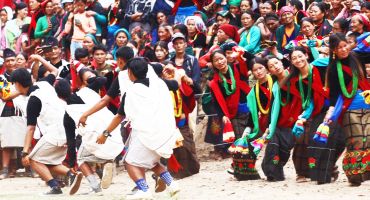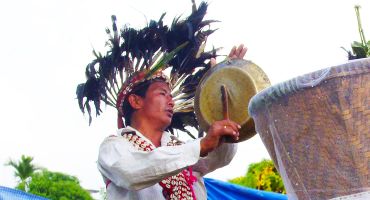Khambu shamanic tradition states that a Shaman (Mangpa/Nakchhong) is chosen by the spirits and that this selection happens when one is born with awakened consciousness or energy. This consciousness, known as “Chhi” or “Chha” is supposedly capable of accessing vibrations that are subjectively defined as a psycho-spiritual effect, experienced as an intense stirring within and through oneself. The Khambus explain this as the receiving of an external spirit into the body, however briefly. These embodied agencies or spirits are independent entities who either incarnate to fulfill their agendas or can be summoned at the will of the Shaman. Such contact with spirits always occurs in altered states of consciousness.
There are several types of Khambu Shamans or Mangpas. There are Nakchhongs who can only perform household lineage rituals or the ones who can conduct Lam Pakma, the rites of passage and seance. Some have the capability of performing Sakela rituals, while others can perform exorcism involving external entities, unrelated to the clan. The ‘flower’ Shaman, Bungpenmi/Bungmangpa, however, is the most inimitable one. He is unique, for he views life essence as flowers and heals the ailing, using it. Bungpenmis are very rare among a host of different types of Shamans in the Kirat Khambu Rai tribe. Bungpenmis revere Budahang- a divine ancestral spirit.

For the Bungpenmi, the human body is embellished with imperceptible, rare flowers found in the mountains, hills, and plains. An impure body could cause these flowers to move from their usual position, or wither away, thereby creating health problems. For mental composure and good health, these body flowers need to be in their correct spots. The Khambu concept of life essence or life breath is centered around different levels of souls, all equally important for physical and spiritual well-being. Various levels of conscious and subconscious spiritual essence such as Lawa, Saya, Nungwa, Sakma, Sakon, and the physical body, function as one unit to give life and health to an individual. This unit must remain intact and whole for spiritual, mental, and physical health.
The shamanic concept of illness is usually about the loss of vital essence (saato haraunu) or some individual dishonor (seer dhalnu), which can occur for various reasons, including fright, a transgression, or a play of negative energies. Other illness reasons could include the consequences of external intrusion in the body. When a person is afflicted with such, the invisible flowers on the body are displaced, and the Bungpenmi must make appropriate adjustments. This healing ritual is called Bungwa Bakma.
Bungwa Bakma is performed right after Sakela Dongdawa (Descending Period/Udhauli). The Bungpenmi has an apprentice called Chuptungmi, who also has an assistant called Dengsungmi. They help the Bungpenmi collect rare Himalayan flowers required for this ritual. These flowers, essential to the rite, usually grow on the most remote terrains of the Himalayan foothills. Bungpenmis have a list of 362 flowers that only they can identify with precision. Since these flowers will be used in the ritual to honor Budahang, the Bungpenmi must sing the Mundhum (ritual language) to explain and justify the picking of these flowers to the divine spirit. Thus, while collecting them, the Bungpenmi is in a constant Shamanic trance as he repeatedly keeps chanting the Mundhum. An error could be fatal to the physical well-being of the Bungpenmi and his assistants. This marks the beginning of the Shaman’s spiritual journey and the success of the ritual, therefore, falls not only on the Shaman’s ritual chanting but also on his ability to pick the right flowers. Finding specific flowers is imperative to the success of the ritual’s outcome. Special care is demanded to avoid ‘impurities’. A flower, once plucked, must be covered with its own leaves, before being collected in a bag.

Before the ritual, everyone gathers at the house of the clan elder to finalize the appropriate date for the ritual. Usually, the village elder’s house will be chosen as the venue for Bungwa Bakma. The entire village participates in the welcoming, hosting, and managing of the ritual. Select members of the house that hosts the ritual, must take alcohol-filled dried gourd (Wabuk/Chindo) to the Bungpenmi to summon him. The Bungpenmi agrees to the date and the venue and gives his word to be there for the ritual. Extended family members are invited on the suggestion of the Bungpenmi The invited members will bring alcohol, ginger, and rice grains as offerings. These offerings come from female members and are called Chhetkusaya.
The occasion possesses a certain solemnity. A feast is prepared, the house and the hearth are cleaned and purified, and the participants wait for the Shaman. The Bungpenmi arrives carrying the flower basket (Bungwa Paanti), and the assistant holds the bag filled with flowers. They are greeted with a gourd full of alcohol each. Traditional Khambu white turban, Sayabung, is placed over their heads to honor them. The assistant will then distribute the alcohol among them all for a drink. After a drink, the Bungpenmi asks for formal permission from the family to begin the ritual. This ritual, which lasts a day, shows that ancestral spiritual energy is the ultimate source of authority as the rules of the ritual demand absolute precision. For a moment, the Shaman exists only as a human representative of a tradition that relies, above all, on the transcendent source of ancestral spiritual energy.
Before the ritual begins, a bed of banana leaves is laid out before the Hearthstones (Suptulung)- the sanctum sanctorum of the Kirati Khambus. Rice grains, ginger, and a gourd full of alcohol are placed nearby. Another banana leaf is placed atop to cover them. Upon that leaf, more rice grains, ginger, and required flowers are spread out. To the left side of these two leveled offerings, there is a grail of water. Green sprigs of the Castanopsis plant (Chille Kattus) soak in this water. The ritual also requires millet beer (Charima Wasim) in a cup and in a traditional wooden grail called Kathuwa. The Bungpenmi, who now begins his role as the officiant, is seated before the altar and begins the rite. Chanting the Mundhum ritual speech, he verifies the presence of the tutelary spirit and begins the divinatory phase of the ritual. The ritual flowers are employed to look into the past, present, and future.
The Bungpenmi organizes the flowers upon the Banana leaf sequentially, concerning its usefulness and symbolism. He then holds the flower container while chanting the Mundhum ritual speech relentlessly. At each instance that a Bungpenmi mentions a flower, the assistant picks up that particular flower and gives it to him. At different periods, the rite allows for a brief break (Tumdhama). Some alcohol is imbibed as an offering. At this moment, the flower container is placed underneath the ritual altar. These are small relational nodes of connection between souls and the flowers where the Bungpenmi collectively converses with the divine spirit in an autonomous yet coordinated way.
Beginning with the father, the Bungpenmi, following exact hierarchical order, asks for the clan, lineage, and origins (Pacha, Samet, Sohon) of everyone present. The daughters and other young participants place rice grains and money as offerings to be utilized along with the flowers for divination. By slicing the Ginger Rhizome (Kachur), the Shaman attempts to obtain precise information about the nature and seriousness of any problem that could have come upon the family members. Owing to this information, the Shaman uses the physical, tangible flowers to see and transform the center of gravitation for all realities and reposition and align all imperceptible flowers, thereby healing all ailments.
Outside the house, a rooster has to be sacrificed. Its blood cannot touch any of Budahang’s flowers. In evoking the connection between the transcendent forces and the ritual, the motif of the Rooster offering also leads us to consider another basic theme, characteristic of Bungwa Bakma. While the flowers are for the declared purpose of calling the attention of the Budahang spirit, the aim of the Rooster offering, at this phase, is to appease the presence of other divine entities that have somehow permeated into the ritual space. The myth says:
Waarihang and Kumdapuhang are the other names of Budahang. Badetkumma and Saisakumma are his two wives. These two wives did not get along with each other. The Mundhum says that the other name of Badetkumma is Dolokumma. There was once a fight between Badetkumma (Dolokumma) and Saisakumma where they used magical powers against each other. In the duel, Dolokumma attacked Saisakumma’s vision and blinded her. From that day onwards, Saisakumma’s suffering became eternal. She also crawls because she cannot walk.
While worshipping Budahang, the flowers that represent him are positioned near the Hearthstones. Similarly, Dolokumma is also worshipped inside the house. Only the Rooster sacrificial rite is performed outside to appease Saisakumma. While worshipping Saisakumma, the Bungpenmi, to emulate the suffering of the divine female spirit, crawls up to the threshold for the sacrificial rite. The tradition of rooster sacrifice, in honor of Saisakumma, besides conceptually catering to the idea of revering the ancestor spirit, can also be inferred as a ritual connected with the space in which the healing takes place. The surrounding becomes a manifestation of human empathy, the realm within which Khambu rites find a form of human expression. This rite is to relieve the suffering of Saisakumma, which will, in return, ultimately help heal the suffering of the living.

While crawling outside, the Bungpenmi carries a flower container, a gourd or grail of water, and chants the Mundhum continuously. This part of the ritual is also known as Saisla. Now alcohol and water are offered and Kachur is carried out. The ritual has animated the surrounding space to allow for healing. The conceptual opposition between well-being and suffering has been ratified by ritual. Now, the Bungpenmi has to aid the return of the invoked ancestral spirits. At the end of the session, all the items employed during the ritual are gathered and taken towards the north, and duly honoured with libations of beer. The participants all drink a little alcohol and eat the Rooster meat as offerings.
The ritual, that sees an ailment as an unstable apparatus detrimental to humans, thus transforms, as a self-correcting attribute of nature, into a potent process at human disposal to urge the ancestor spirits to exchange for their offerings, the gift of well-being. Bungwa Bakma demonstrates that it is through the will of the Bungpenmi that men can utilize to their exclusive advantage, the obligations stemming from this correlation of ritual exchange.





Leave a Reply